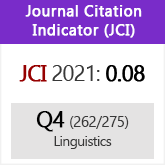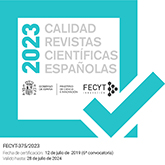Introducing a scansion machine for Dutch poetry and prose
DOI:
https://doi.org/10.3989/loquens.2014.002Keywords:
stress-timed rhythm, Dutch, poetry, scansion, iambic pentameterAbstract
This paper looks into the possibility that the rhythm present in poetry is the same that characterizes natural languages. This hypothesis, although attractive, faces serious problems such as the tremendous amount of data necessary to reach any valid conclusion and the fact that certain poetic traditions may deviate from the rhythm expected in a certain language. In order to tentatively test whether there is a relationship between the rhythmic properties of a certain language and its poetry we selected Dutch, a stress-timed language, and we took modern Dutch metric poetry as the object of study. Then, we created a tool that finds regular patterns of stressed and unstressed syllables in iambic pentameters and we compared our results to those of de Groot (1936). Finally, we discussed what factors could influence the noticeable findings for the beginning and the end of the studied verses and whether these findings could be the same for Dutch prose texts.
Downloads
References
De Schutter, G. (2012). De werkwoordelijke eindgroep en nog steeds geen einde? [The verbal endgroup and still no end?] Verslagen & Mededelingen van de KANTL [Reports & Messages from the KANTL], 122(1), 1–38.
Dryer, M. S., & Haspelmath, M. (Eds.). (2013). The World Atlas of Language Structures Online. Leipzig, Germany: Max Planck Institute for Evolutionary Anthropology. Retrieved from http://wals.info
Fabb, N. (in press). The verse-line as a whole unit in working memory, ease of processing, and the aesthetic effects of form. Royal Institute of Philosophy Supplement, 75.
Fabb, N., & Halle, M. (2008). Meter in poetry: A new theory. Cambridge, UK: Cambridge University Press. http://dx.doi.org/10.1017/CBO9780511755040
Fabb, N., & Halle, M. (2012). Counting in verbal art. In I. Jaén & J. J. Simon (Eds.), Cognitive literary studies: Current themes and new directions (pp. 163–182). Austin: University of Texas Press.
Gómez, D. M., Berent, I. Benavides-Varela, S., Bion, R. A. H., Cattarossi, L., Nespor, M., & Mehler, J. (2014). Language universals at birth. Proceedings of the National Academy of Sciences of the United States of America, 111(16), 5837–5841. http://dx.doi.org/10.1073/pnas.1318261111 PMid:24706790 PMCid:PMC4000834
de Groot, A.W. (1936). De structuur van het vers [Verse structure]. De Nieuwe Taalgids [The New Language Guide], 30, 197–212. Retrieved from http://www.dbnl.org/tekst/_taa008193601_01/_taa008193601_01_0029.php
Kazartsev, E. (2010). Nederlands en Duits versritme in de vroegmoderne tijd [Dutch and German verse rhythm in early modern history]. Neerlandistiek.nl, 10(01). Retrieved from http://dspace.library.uu.nl/bitstream/handle/1874/190508/article.pdf?sequence=2
Langus, A., & Nespor, M. (2013). Language development in infants: What do humans hear in the first months of life? Hearing, Balance and Communication, 11(3), 121–129. http://dx.doi.org/10.3109/21695717.2013.817133
Meulen, M. S. van der (2014). Het ritme van rood en groen. Unpublished research report, Leiden University, the Netherlands.
Nespor, M., Shukla, M., & Mehler, J. (2011). Stress-timed vs. syllable-timed languages. In M. van Oostendorp, C. J. Ewen, E. Hume, & K. Rice (Eds.), The Blackwell Companion to Phonology (pp. 1147–1159). Malden, MA: Wiley-Blackwell.
Patel, A. D., & Daniele, J. R. (2003). An empirical comparison of rhythm in language and music. Cognition, 87(1), 33–45. http://dx.doi.org/10.1016/S0010-0277(02)00187-7
Shukla, M., & Nespor, M. (2010). Rhythmic patterns cue word order. In N. Erteschik-Shir & L. Rochman (Eds.), The Sound patterns of syntax (pp. 174–188). Oxford, UK: Oxford University Press. http://dx.doi.org/10.1093/acprof:oso/9780199556861.003.0009
Zonneveld, W. (1992). Van Afflighem en Chaucer. Het leven van Sinte Lutgart als jambisch gedicht [Van Afflichem and Chaucer. Iambic poem of the life of Saint Lutgart]. Amsterdam, the Netherlands: Stichting Neerlandistiek VU.
Zonneveld, W. (1993). 700 jaar Nederlandse klemtoon (en weinig veranderd) [700 years of Dutch stress (and little has changed)]. Spektator, 22, 198–222.
Published
How to Cite
Issue
Section
License
Copyright (c) 2014 Consejo Superior de Investigaciones Científicas (CSIC)

This work is licensed under a Creative Commons Attribution 4.0 International License.
© CSIC. Manuscripts published in both the printed and online versions of this Journal are the property of Consejo Superior de Investigaciones Científicas, and quoting this source is a requirement for any partial or full reproduction.All contents of this electronic edition, except where otherwise noted, are distributed under a “Creative Commons Attribution 4.0 International” (CC BY 4.0) License. You may read here the basic information and the legal text of the license. The indication of the CC BY 4.0 License must be expressly stated in this way when necessary.
Self-archiving in repositories, personal webpages or similar, of any version other than the published by the Editor, is not allowed.
















